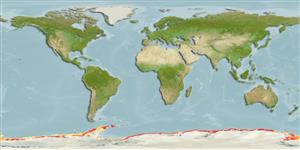Issue
The genus Pseudotrematomus is a synonym of Trematomus, which is confirmed by a molecular study to be published (J.-C. Hureau, pers. comm. 08 Jun. 2010).
Environment: milieu / climate zone / depth range / distribution range
Ecologia
marinhas demersal; intervalo de profundidade 70 - 650 m (Ref. 26875). Polar; 60°S - 78°S
Southern Ocean: continental shelf of Antarctica and nearby islands, including the South Orkney.
Comprimento de primeira maturação / Tamanho / Peso / Idade
Maturity: Lm 22.0, range 19 - 26 cm
Max length : 34.5 cm TL macho/indeterminado; (Ref. 87549)
Espinhos dorsais (total): 6 - 7; Raios dorsais (total): 36-38; Espinhos anais 0; Raios anais : 34 - 36; Vértebras: 54 - 57. Second dorsal-fin rays 0-3 more than anal-fin rays. Preopercular-mandibular canal with 10 pores; infraorbital canal with 6-8 pores; supra-orbital canal with 4 pores; coronal commissure with a single median pore; temporal canal with 5-6 pores; supratemporal canal complete wit 3 pores. Body and head almost entirely scaled, including snout, preorbitals, posterior part of maxilla, lower jaw, isthmus, branchiostegal membranes and proximal parts of branchiostegal rays.
Color: In alcohol, ground color buff, with a chequered pattern formed by staggered dark blotches along the dorsal, lateral and ventral parts of the body; ventral dark blotches may appear as short wavy horizontal dark marks. Snout, occipital region and sometimes interorbital area are dark.
Most common in shallower waters of the continental shelf, especially on banks less than 250 m deep in areas where local upwellings increase food supply (Ref. 6390). Juveniles are found near the surface, often in association with Antarctic krill (Euphausia superba) swarms. Feed on salps, nudibranchs, amphipods, copepods, polychaetes, krill, crustaceans, chaetognaths, and fish (Ref. 6390).
Mature females may spawn for the first time from around 7-9 years of age (Ref. 71843).
Dewitt, H.H., P.C. Heemstra and O. Gon, 1990. Nototheniidae. p. 279-331. In O. Gon and P.C. Heemstra (eds.) Fishes of the Southern Ocean. J.L.B. Smith Institute of Ichthyology, Grahamstown, South Africa. (Ref. 5179)
Status na Lista Vermelha da UICN (Ref. 130435)
Ameaça para os humanos
Harmless
Uso pelos humanos
Pescarias: espécies comerciais
Mais informação
ColaboradoresFotosStamps, Coins Misc.SonsCiguateraVelocidadeTipo de nataçãoÁrea branquialOtólitosCérebrosVisão
Ferramentas
Relatórios especiais
Baixar XML
Fontes da internet
Estimates based on models
Preferred temperature (Ref.
123201): -1.8 - 0.9, mean -0.9 °C (based on 436 cells).
Índice de diversidade filogenética (Ref.
82804): PD
50 = 0.5005 [Uniqueness, from 0.5 = low to 2.0 = high].
Bayesian length-weight: a=0.00490 (0.00331 - 0.00724), b=3.26 (3.14 - 3.38), in cm total length, based on LWR estimates for this species & Genus-body shape (Ref.
93245).
Nível Trófico (Ref.
69278): 3.4 ±0.1 se; based on diet studies.
Resiliência (Ref.
120179): médio(a), tempo mínimo de duplicação da população 1,4 - 4,4 anos (Fec = 1,400-12,854).
Fishing Vulnerability (Ref.
59153): Moderate to high vulnerability (52 of 100).
Climate Vulnerability (Ref.
125649): High to very high vulnerability (66 of 100).
Nutrients (Ref.
124155): Calcium = 26.8 [16.2, 66.0] mg/100g; Iron = 0.498 [0.197, 0.983] mg/100g; Protein = 17.1 [16.1, 18.2] %; Omega3 = 0.384 [0.215, 0.659] g/100g; Selenium = 15.5 [6.7, 34.6] μg/100g; VitaminA = 22.2 [4.9, 102.6] μg/100g; Zinc = 0.473 [0.314, 0.718] mg/100g (wet weight); based on
nutrient studies.
